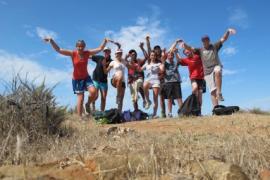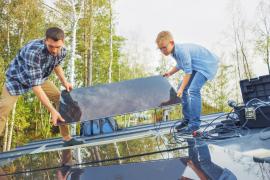In May 1971, the Five Man Electrical Band's "Signs" peaked at number eighteen on the rock and pop charts. For the unfamiliar, it's about excluding others through signs like job descriptions that refer to applicants' appearance or prohibiting trespassing. And while laws have changed with the times, signs still set the tone for the impressions that people build. In this column, we're going to look at how signs to, at, and around camp can improve the experience of your neighbors, visitors, camp families, and staff.
Hansel and Gretel
Many rural camp programs are truly rural. You seldom get accidental visitors, and when you do, they're truly lost. Of course you don't get lost going to camp, because you've been there before and know where you're going — but what about the first-time visitors? Many of my client camps' Web sites say very explicitly that travelers need to follow the Web directions to camp, since Garmin, TomTom, and the other GPS-based navigation systems will not get you where you need to go. Understandably, those systems spend enormous amounts of time, money, and effort updating maps where the most people are, and again, that's the exact opposite of "rural," right?
Despite the warnings (if they've been read at all), many expect their navigation unit to work as flawlessly in your corner of Podunk as it does in Manhattan, Dallas, or Los Angeles. On top of that, most modern suburban and urban drivers expect to be able to call camp by cell phone for directions if the GPS leads them astray, and we know how well that works. Knowing the area, though, you're ideally suited to help campers, staff, and parents help themselves by placing directional signs very deliberately along the route into camp from every possible direction. They can be very simple and relatively inexpensive, telling drivers what the destination is and how far it is to the next turn. Use consistent coloring and layout so that people recognize your sign from far enough away that they can prepare to read and digest it before it's behind them. For example, if your camp colors are gold on sky blue, use that color scheme for the camp's name on every sign, perhaps with a mileage until the next turn underneath and an arrow over top. Consider going the extra mile by borrowing several different brands of navigation units and providing turn-around and retrace instructions at the dead ends where they lead. Or, if you don't have a device, at least guess as to where they may lead: closed road, washed out bridge, etc.
There's nothing that can replace a first impression, and if the driver (usually the tuition payer or group planner) arrives late, tired, and ticked off at having been lost, your opportunity to make a good first impression is gone, regardless of whether your Web site "told them so" or not. Will it work? Ask any southwest Pennsylvania residents how to get to Kennywood, and they're likely to tell you all about the distinctive black-on-yellow arrows that have left little doubt on the route for nearly a hundred years. You're more likely to "get lost" by not wanting to come home!
There may be one more avenue that you could consider: Many municipalities have provisions for temporary signs such as those for elections, yard sales, etc. With a little effort, you could have or make signs that meet those requirements, and post them along the way with land owners' permission. You'll likely be required to remove them after a set period of time, but this is an opportunity, not an obstacle, because you'll interact directly with landowners along the way. On top of that, you will have a chance to look them over for fading and wear at the end of each season. Lost, tattered, or worn signs to camp will be a thing of the past!
It's important to mention that many municipalities and counties have sign regulations, particularly those which are off-premise. While those are usually the traditional billboards, we've seen many ordinances that don't differentiate. Moreover, be warned that utility poles are owned by someone (usually a utility company), and they usually have prohibitions against stapling, nailing, or otherwise affixing signs to their "outside plant." Before you embark on a foolproof plan to guide the most directionally challenged to camp flawlessly, make sure that you research, understand, and comply with all of the regulations you can find. Start by contacting the municipal government in which the signs will be posted. Tell them what you're thinking about and ask if they have or are aware of regional rules governing this sort of thing. If you think that you want to use utility poles, that's going to be a more involved exercise since several utilities may use the poles and pay rent to a single owner. You can start by copying down all of the numbers from one such pole and calling the local power, cable, or telephone company. They should be able to tell you who owns the pole and how to reach that company's outside plant / real estate management division.
But what about the route itself? Older readers of Camping Magazine will fondly remember "Burma Shave" signs that entertained travelers early in our country's motoring history. Although they're gone from American roadsides, another campaign has replaced them. Most areas have an Adopt-a-Roadway program where organizations, businesses, or individuals sponsor a section of roadway for litter pickup. In exchange for keeping the roadside litter free, the sponsor is thanked by a sign at either end of their assigned section. You can imagine that this commitment carries great risk in exchange for the great reward. It's unfortunate that litter doesn't stay "picked up" — it seems like there's another litter bug making a mess as fast as you can clean it up. It requires much care and effort to ensure that the sign doesn't tout camp as inattentive, unwilling to meet its commitment, or simply looking to cash in on free advertising, but the benefits are unmistakable.
First, many camps tend to become isolated from the community in which they are located. Nonprofit organizations are often perceived as not providing anything in exchange for their non-payment of local taxes, but by conscientiously maintaining their Adopt-a-Roadway segment, they're providing a continuous reminder to the community that they are indeed participating and giving back to the community, not just because they say so, but in ways that people can see and appreciate. Next, by keeping the roadways into camp picked up and litter-free, you effectively extend the entrance to camp and set the stage for a wonderful arrival in just a few miles. Finally, by having everyone on staff take a turn maintaining the approach to camp, everyone is invested in the cleanup process both off camp and within the property. Staff will set an example that campers will emulate, and you'll be growing leaders just like your marketing material says you will. Remember though, that like the Mail Pouch tobacco barn sides that have faded into obscurity (along with the product they promote), the result of camp's effort and commitment will reflect your organization.
“You Are Here”
So having received permission from municipalities and utility companies, you've guided every one of your guests to the entrance to camp along a glittering, gleaming route of litter-free beauty. (I'm an eternal optimist; bear with me.) They enter camp and are greeted by — what? Does your camp even have an entrance sign? Beyond pronouncing that guests have arrived, are they directed and guided to the right place? Although many camps have staff posted to direct throngs of incoming campers to parking, luggage drop, and registration, it's equally important that everyone arriving can find their way to their correct destination, whether it's for food service, maintenance equipment, or office supplies. More urgently, what about the ambulance driver or parent taking a sick camper home? Can they find their way to where they need to be, or are they left to wander and hope for the best? Proper directional signs throughout the property are essential to ensuring that everyone on your facility arrives where you, the owner or director, want them. Sure, security concerns should limit how much information is available to people who don't have a "need to know." But at the same time, new arrivals should be able to determine quickly and without question where they need to go and how they need to get there, at any hour of the day or night, and under any weather conditions. Clear, concise, and well-designed signs are the most straightforward and effective mechanism to accomplish that.
Facilities that are occupied from spring through fall must also consider that adults tend to be more comfortable at (and therefore more likely to return to) properties where they can figure out where they are and how to get where they want to go nearly instantly. Printed maps are just one way to convey that information. While simpler is better, a hand-drawn, out of proportion, or cartoonish sketch is little comfort to someone who's already anxious about being somewhere unfamiliar. Consider instead large, permanent, colorful signs at strategic places on the property marked "You Are Here," and matching printed versions. If this approach sounds familiar, let's just say that malls and theme parks across America can't all be wrong.
Where camp has an advantage over those facilities, though, is that color coding trails and pathways is a longstanding means of putting people on the right path at camp. So how long has it been since the trails and paths were re-blazed with a fresh color coat? After all, aren't tree stripes merely simple signs? A well-marked trail is inviting and will be used often. Even people new to the property will be confident that the map in their hand and the blazed trail before them will take them where they want to go.
What, then, about the temporary signs that direct masses of folks during move in, visiting, or camper pickup? Here again, is an opportunity to make a great impression without spending a fortune. If camp's been doing things the same way every year and nobody foresees changes, go ahead and have signs made that can be mounted on easels (indoors) or saw horses (outdoors). Think through how they'll be kept in place and mount hardware to accomplish that. Leave the binder clips, duct tape, and thumb tacks in the office where they belong. If things are more fluid, consider engaging a staffer (if you're lucky) or a local window paint artist (if you're not so lucky) to prepare instructions and signs on white boards. Good quality, bold markers don't fade and they're water resistant. I have yet to see the white board that's curled in the rain, or faded beyond legibility. Present a planned, finished appearance at every opportunity and you'll be delighted at the return on investment.
Make your campers and other guests at home on your site! Nothing can replace that like a well-thought-out and executed signage plan. From guidance to get people to camp, to passive help around the property, it's one of the really small things that make the organization and property truly stand out as a memorable destination and one they want to return to.
Rick Stryker is a professional engineer with a particular passion for helping camps with infrastructure, planning, and regulatory issues. He can always be reached at campfc@ptd.net or (570) 828-4004.



